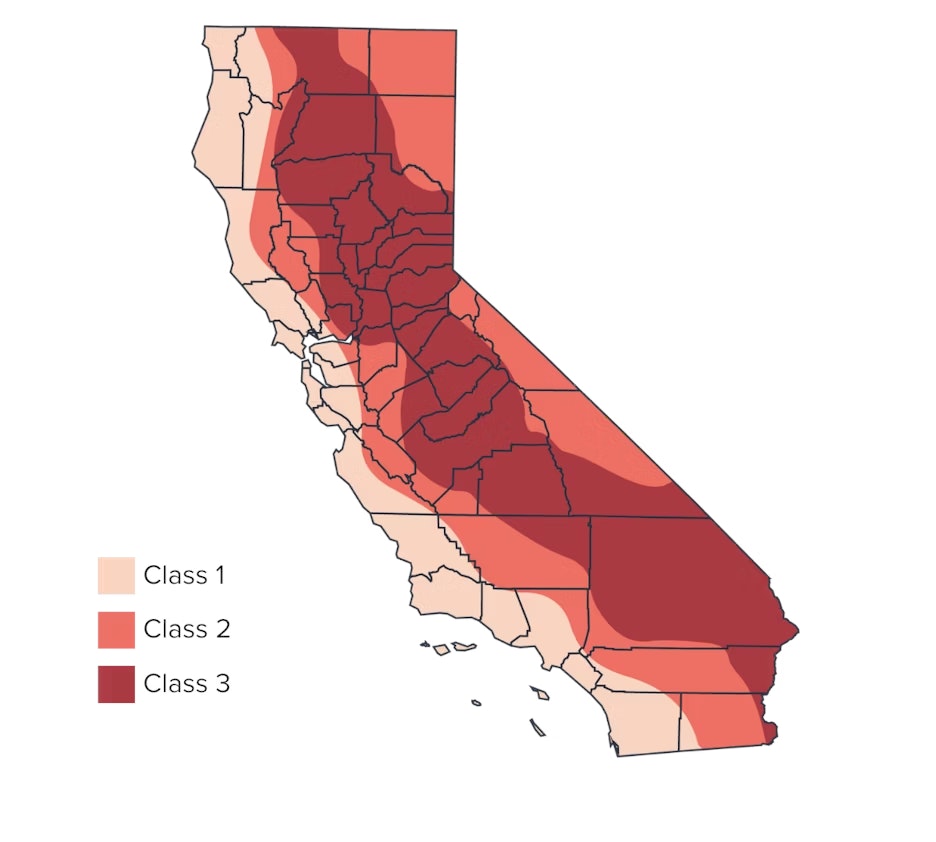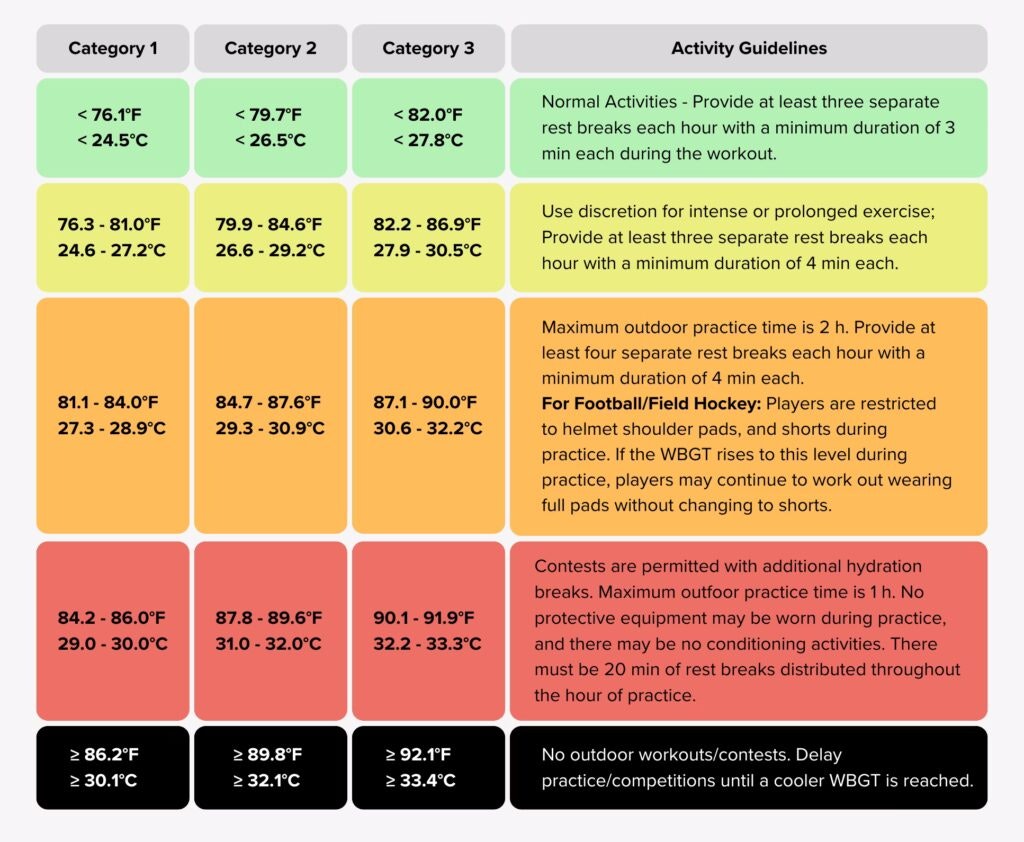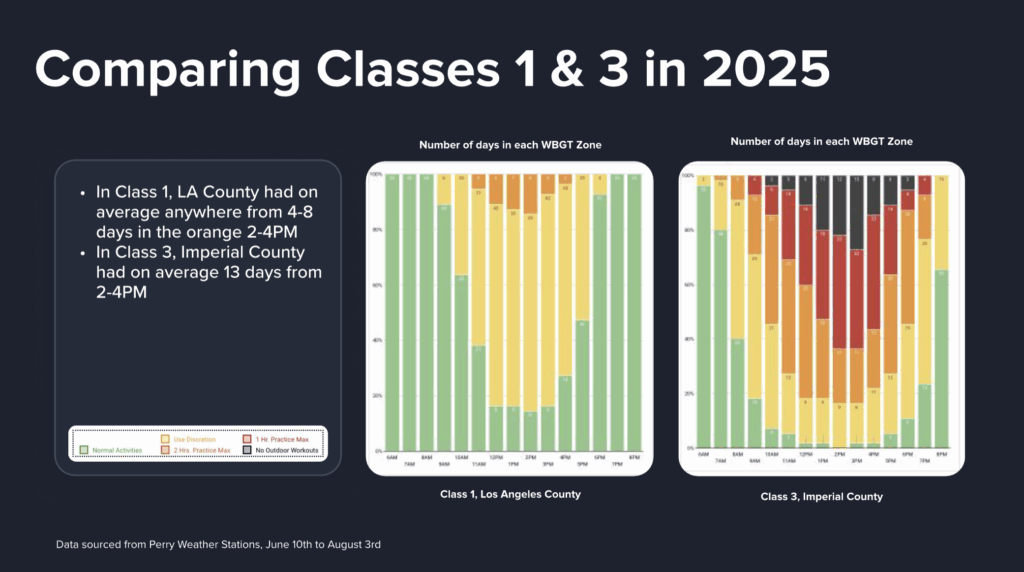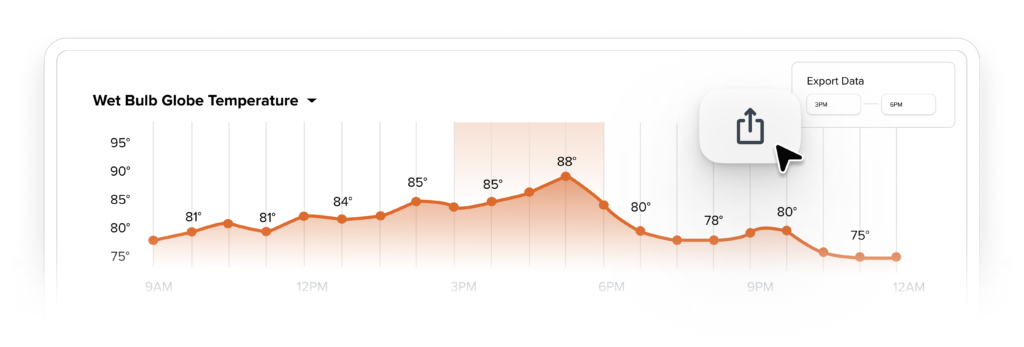Preseason in California is already a balancing act—hot inland afternoons, cooler but humid coastal mornings, and the occasional desert-level heatwave. California schools are staring down real heat, plus real complexity.
CIF’s wet bulb globe temperature (WBGT) policy isn’t one-size-fits-all; it reflects the state’s wildly different microclimates with three categories and zone-based triggers that change what you can do, when you can do it, and what athletes should wear.
To help coaches and staff prepare, we hosted a preseason webinar with Kristen Dizon, Head Athletic Trainer at Agoura High School and CIF Sports Medicine Committee member; Mark Moreno, Head Athletic Trainer at Bellarmine College Prep; and Colin Perry, CEO of Perry Weather.
The panel discussed how to take WBGT readings, interpret zone changes in real time, and use tools like automated alerts and forecasts to protect athletes without losing critical practice time.
What The CIF Webinar Covers
- How CIF’s three WBGT categories work across California
- What to modify by zone and sport
- Practical acclimatization steps for the first two weeks
- Why handheld WBGT can fail in real use
- How automation saves time and reduces mistakes
- Real California data: LA County (Category 1) vs Imperial County (Category 3)
Key Takeaways from the CIF Webinar

Not All Zones Are Treated Equally—And That’s the Point
California is uniquely challenging when it comes to creating statewide weather safety policies. Its geographical diversity includes cooler coastal zones, arid deserts, and microclimates scattered across inland valleys.
As Kristen Dizon noted, “Our landscape is just so different… we have the coastal regions, we have the deep desert regions, we have the Inland Empire.” That variation is why CIF created three WBGT categories—Class 1, 2, and 3—to better reflect regional realities.

Class 1 schools (coastal, cooler) have more restrictive thresholds. Class 3 schools (desert regions) face higher heat but are more acclimated. CIF is even considering a possible Category 4 for extreme desert regions.
Microclimates Matter—And Reclassification Is Possible
WBGT categories are broad, but even within a zone, localized differences can impact heat conditions. Kristen noted, “Even within the regions, there’s subdivisions.” Schools can request reclassification if they collect accurate data—Perry Weather’s on-site stations help make that case with credible evidence.
Acclimatization Is Foundational for Athlete Safety
Most student-athletes return from summer break under-conditioned. Mark Moreno said, “They’re not pro athletes… they’re hanging out with their friends… not drinking all the water they need to.”
CIF policies emphasize a two-week ramp-up period, allowing students to adapt gradually—especially high-risk groups like linemen or long-distance runners.
Handheld Devices Fall Short of Accurate Monitoring
Handheld WBGT meters require 20+ minutes to acclimate and often lack key sensors. Colin noted that “if your device does not have any sort of wind vane or wind propellers, you’re not going to be getting an accurate wet-bulb globe.” Without proper equipment, schools risk making unsafe or overly cautious decisions.

All Outdoor Sports Require WBGT Planning
WBGT doesn’t just apply to football. Kristen shared how she adapts cross country training based on heat, sometimes limiting students to campus runs for better safety oversight. Water polo is also under review; CIF may shift policies toward monitoring water temperature and deck conditions.
On-Campus Weather Data is Non-Negotiable
Relying on weather stations from nearby cities can skew readings. Mark described a wind tunnel on his campus that affects cooling. Kristen mentioned, “A lot of weather data was coming from Malibu… that is a very big difference in temperature.” On-site weather monitoring platforms like Perry Weather capture hyperlocal, actionable data.
Giving Coaches Access Improves Compliance
When coaches can see the same data as trainers, it builds trust and accountability. Mark said, “Our coaches feel better when they have some knowledge… so they can look at it and say, oh yeah, OK, it is red.” Kristen noted that this transparency “opened up the communication back and forth more effectively.”
Comparing CIF’s WBGT Data: What It Reveals
Class 1 vs. Class 3 Regions See Drastically Different Heat Risk Profiles

- LA County (Class 1) had a mild summer with minimal black zone hours.
- Imperial County (Class 3) experienced 13 black zone days between 2–4 PM—a key practice window.
Perry Weather’s real-time monitoring reveals major differences in regional heat exposure. Schools in hotter zones face more restrictions—and having on-site, accurate WBGT monitoring helps them make the most of limited safe windows.
Practice Time Inequity Makes WBGT Monitoring Essential
- Class 1 schools can hold longer practices with fewer restrictions.
- Class 3 schools must navigate constant risk and frequent zone escalations.
- CIF’s zoned policy attempts to balance this, but success depends on accurate, real-time data.
Perry Weather can help schools respond quickly and confidently to fluctuating conditions—giving all athletes the safest and fairest experience possible.
On-Site Sensors Capture Crucial Microclimates
- Mark’s campus gets a daily cooling effect from a localized wind tunnel.
- Kristen’s pre-Perry Weather data came from Malibu, which didn’t reflect actual on-campus conditions.
- Even schools just 10 minutes apart report drastically different WBGT readings.
No free weather app or nearby station can account for on-campus microclimates. Perry Weather’s on-site systems provide hyperlocal accuracy that regional data simply can’t replicate—critical for heat safety compliance.
Historical WBGT Trends Guide Smarter Scheduling
Perry Weather logs WBGT data over time, helping schools spot patterns, identify peak-risk time slots, and justify policy adjustments or reclassifications.

Historical data is power. With Perry Weather, schools don’t have to rely on guesswork. They can show patterns, prove compliance, and optimize schedules year over year.
FAQs from the CIF Webinar
How do I know what WBGT category (1–3) our school is in?
Use Perry Weather’s CIF WBGT Region Search Tool—type your school/district and get the category instantly.
How should coaches handle WBGT changes mid-practice?
Adjust conditioning intensity and hydration, even if gear removal isn’t immediately required.
Handheld vs. stationary WBGT monitors—what’s more accurate and easier to use?
The webinar explains key differences: handhelds need acclimation and are prone to spikes; stationary stations (with radiation shielding and standard-size black bulb) provide continuous, consistent data and reduce human error.ha
How long should a handheld WBGT device (e.g., Kestrel) acclimate after moving indoors→outdoors?
Plan on ~30 minutes for stable readings; frequent movement disrupts accuracy.
Can the Kestrel 5400 be programmed with zones by location?
You can enable and set up to 6 custom WBGT “zones/flag” thresholds on the device, but it doesn’t geofence itself to your location—thresholds are configured by the user and don’t change for each location.nd
Does Perry Weather give “weekly predictions,” and are those from a meteorologist?
Perry Weather provides predictive heat-stress outlooks/forecasts in-app (e.g., 72-hour work/rest forecasting) and offers 24/7 Pro Meteorologist Service for human consultation. The weekly planning view is model-driven; meteorologists are available when you need them.
If we start practice in one category and the WBGT shifts (e.g., orange→red), what do we follow?
Set your practice plan based on the WBGT at start time and continue using those limits, while monitoring for major changes. If WBGT reaches black, stop and reassess after ~30–45 minutes. (General guidance; check your local rules.)h
If a Category 1 team plays a Category 3 team, whose zones apply?
WBGT policy follows the site of play. You measure and comply with the host location’s readings/thresholds at that time—not the visiting team’s home category.
Full pads—are we really restricted all season?
Not necessarily. Equipment restrictions depend on current WBGT and where you are in heat-acclimatization days. Check your Section’s chart and CIF Extreme Heat/Air Quality Policy.
For sports without equipment (XC, tennis, golf), how do we apply this without canceling everything?
Policies apply to outdoor practices across sports.
How do we apply the policy to water polo?
If outdoors, apply the WBGT thresholds just like other outdoor sports. If indoors, follow your Section/district indoor guidance and heat-stress best practices. The CIF heat-stress rules specifically reference outdoor practices.
What about off-campus venues (tennis, golf, beach volleyball, aquatics)?
Measure at the site. If you don’t have a station at that location, the webinar noted you can use a nearby station (≈4–5 miles) or take handheld WBGT readings on site for the most accurate data.
Where should a Perry Weather station go—press box, roof, or ground?
Choose a spot that represents the overall campus climate, with unobstructed wind/sun exposure. Rooftop/press-box installs are fine—Perry Weather adjusts wind to 2-meter equivalents to keep WBGT accurate.
Where would a station typically be located on campus?
Common placements: press boxes, field houses, or rooftops near the primary outdoor venues—again, prioritize clear exposure over proximity to a single surface.
Is the “cooling zone” trigger 80°F or higher or or lower?
CIF language references providing cooling zones when WBGT ≥ 80°F (and having cold-water immersion available). Always confirm your Section’s implementation.
Are there grants or affordable options for small schools?
Perry Weather provides a free trial so you can evaluate fit before purchasing. Perry Weather works with schools of all sizes.(For quotes/tiers, contact sales.)
Thanks for joining us. We hope the CIF webinar gave you practical takeaways for managing heat stress and keeping athletes safe. Perry Weather removes the guesswork from weather safety decisions—try it yourself with a free two-week trial.














